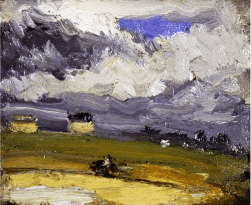Click here to see this email on the web
|
 |
Thursday, July 6th, 2023
|
|
Passion Play
|
By Christopher Volpe
|
Share this article:    
|
 |
Robert Henri, West Coast of Ireland, 1913, oil on canvas, 66 x 81.3 cm, Everson Museum of Art, Syracuse, NY.
|
Art opens a portal into a timeless place. Hours pass unnoticed and small (but no less real) private adventures befall us.
On an intimate, one-to-one scale, painting is full of challenge, excitement, discovery, and it teaches us to live with a heightened sense of being alive. The subjects for new paintings tend to reveal themselves to us when we’re on the lookout, deliberately feeling present, opening our senses, receptive to the wonder and specificity of life. This sense of heightened interest in life can also follow us back into our daily chores and responsibilities, emerging if we let it long after the art supplies are stored until next time.
In fact, the more you lean into this, the more you live “deliberately,” in Thoreau’s word, the sooner you’ll find yourself back at the easel, the wilder and more absorbing your artistic adventures will become, and the more you’ll open up and live your best creative life.
|
 |
Robert Henri (1865–1929), Café du Dome (On the Boulevard Montparnasse) (1892), oil on canvas, 66 x 81.3 cm
|
Beginners are best off learning the tools of art from sound sources and still, right from the start, making wild experiments that let the “crazy artist” within come alive. “When the artist is alive in any person, whatever his kind of work may be, he becomes an inventive, searching, daring, self-expressive creature,” artist Robert Henri told students at the New York School of art, where he taught from 1902 to 1908. Enthusiasm for the life of the artist drives the acquisition of technique, not vice versa.
What happens when you embrace the best artist that you can be affects not just your own creativity but your whole life and those around you. The person in whom the Artist has come alive, Henri says, “becomes interesting to other people. He disturbs, upsets, enlightens, and opens ways for better understanding. Where those who are not artists are trying to close the book, he opens it and shows there are still more pages possible.”
“Art is, after all, only a trace,” he said, “like a footprint which shows that one has walked bravely and in great happiness.”
|
— advertisement —
|
 |
 |
Robert Henri, Concarneau Beach, oil on linen, 1899. In this oil sketch, Henri boldly uses a loaded brush and big and juicy gestural brushstrokes to record the artist’s sense of wonder and vigorous life. Many successful, “cutting edge” contemporary landscapists, particularly in the Cornwall area of England, are painting in just such a manner today, more than 100 years after Henri.
|
It was in art as a means of living life that Henri was interested, not as a means of making a living. Money and collectors would follow, he surmised, as others saw and felt in the work the plain evidence of a soulful expression and a life lived in excitement about being alive. “Deep calls unto deep,” as Emerson said, and works of the heart and soul will inevitably touch the heart and soul of another.
The more people in the world living this way, with a sense of passion and excitement, the better the world would be for us all. “Genius is not a possession of the limited few, but exists in some degree in everyone,” Henri said. “Where there is natural growth, a full and free play of faculties, genius will manifest itself.”
George Inness believed the role of every artist is to embrace a spiritual aspect of sight, a glimpse into the overarching harmony of vision that ties existence together and, by its very nature, makes us human. The man or woman in whom the Artist is alive becomes a vessel of emotional and spiritual content seemingly received from without, yet in reality is vision fused with an emotional-psychological state of elevated consciousness for which “expression is inevitable,” as Henri would say.
|
 |
George Inness, Landscape Study, 1882, 15.75 x 21.75
|
|
|
|
— advertisement —
|
 |
Art is for Everyone
|
 |
Kathleen Hudson, Backlit Sky, plein air, oil, 18×24. Kathleen teaches her landscape methods in a downloadable video, Creating Atmospheric Landscapes
|
Not everyone is willing or capable of acting on the creative impulse, but its wellsprings exist for all. Art is no privileged, elitist specialization. The vast majority of artists and writers living in America have full-time day jobs, often exhausting ones. And yet they’re excited about doing something meaningful, maybe even making a positive difference in someone’s life with their art. Being an artist is something available to anyone committed to living an open, freer life with courage, mindfulness, commitment, and even moments of joy.
“The passionate play goes on,” wrote Walt Whitman, “and you may contribute a verse.”
|
— advertisement —
|
 |
|
|
|
|
|
Inside Art is committed to protecting and respecting your privacy. We do not rent or share your email address. By submitting your email address, you consent to Streamline Publishing delivering regular email issues and advertisements. To end your Inside Art e-mail subscription and associated external offers, unsubscribe here. To learn more about Streamline Publishing events, products, and offerings visit StreamlinePublishing.com
Copyright 2022 Streamline Publishing, Inc. All rights reserved.
Inside Art® is a registered trademark of Streamline Publishing, Inc. |
|
|
|
|